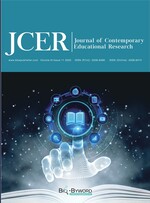Applying Communicative Language Teaching in Classroom English Language Lesson Curriculum
Abstract
This article provides us a specific classroom English language lesson curriculum designed for CLT, attached with a brief lesson plan and some relevant teaching materials. In the introduction, this article first explains the different English teaching methods coming through the last century and the conception and burgeoning of the CLT approach in language teaching, followed by its primary principles as presented by different scholars. Thereafter, the rationales for each activity and the reasons for the choices within the lesson plan are elaborated in detail. Last but not least, the article further evaluates the strengths and weaknesses of the lesson plan, including the method used, activity types, choice of text, etc.
References
Richards JC, 2001, Curriculum Development in Language Teaching, Cambridge University Press, New York.
Richards JC, Rodgers TS, 1986, Approaches and Methods in Language Teaching, Cambridge University Press, Cambridge.
Hymes D, 1972, On Communicative Competence, in Sociolinguistics, Penguin, Harmondsworth.
Canale M, Swain M, 1980, Theoretical Bases of Communicative Approach to Second Language Teaching and Testing. Applied Linguistics, 1(1): 1–47.
Bachman LF, 1990, Fundamental Considerations in Language Testing, Oxford University Press, Oxford.
Halliday MAK, 1970, Language Structure and Language Function, New Horizons in Linguistics, Penguin, Harmondsworth.
Harmer J, 2011, How to Teach English, Longman, Oxford.
Howatt APR, 1984, A History of English Language Teaching, Oxford University Press, Oxford.
Littlewood W, 1981, Communicative Language Teaching, Cambridge University Press, Cambridge.
The Curriculum Development Committee (Hong Kong), (eds) 1981, Syllabuses for Primary Schools, The Printing Department (Hong Kong), Hong Kong.
Swan M, 1985, A Critical Look at the Communicative Approach. English Language Teaching Journal, 39(1): 2–12.
Geddes M, White R, 1978, The Use of Semi-Scripted Simulated Authentic Speech and Listening Comprehension. Audio-Visual Language Journal, 16(3): 137–145.
Hedge T, 2000, Teaching and Learning in the Language Classroom, Oxford University Press, Oxford.
Grabe W, 2009, Reading in a Second Language: Moving from Theory to Practice, Cambridge University Press, Cambridge.
Li X, 1988, Effect of Contextual Clues on Inferring and Remembering the Meanings of New Words. Applied Linguistics, 9(4): 402–413.
Klippel F, 1984, Keep Talking, Cambridge University Press, Cambridge.
Prabhu NS, 1987, Second Language Pedagogy, Oxford University Press, Oxford.
Skehan P, 1996, A Framework for the Implementation of Task-Based Instruction. Applied Linguistics, 17(1): 38–62.
Faerch C, Haastrup K, Phillipson R, 1984, Learner Language and Language Learning, Multilingual Matters, Clevedon, Avon.
Dornyei Z, Ushioda E, 2011, Teaching and Researching Motivation, Person Education, Harlow.
Leonard K, 2019, The Disadvantages of Teamwork in the Workplace, viewed May 20, 2022, http://smallbusiness.chron.com/disadvantages-teamwork-workplace-1937.html
Krashen S, 1982, Principles and Practices in Second Language Acquisition, Pergamon, Oxford.
Littlewood W, 1984, Foreign and Second Language Learning: Language Acquisition Research and Its Implications for the Classroom, Cambridge University Press, Cambridge.
Johnson, 1982, Communicative Syllabus Design and Methodology, Pergamon, Oxford.
Oxford RL, 2001, The Bleached Bones of a Story: Learners’ Constructions of Language Teachers, Language Contributions to Language Learning, Longman, Harlow.
Medgyes P, 1986, Queries from a Communicative Language Teacher. ELT Journal, 40(2): 107–112.

